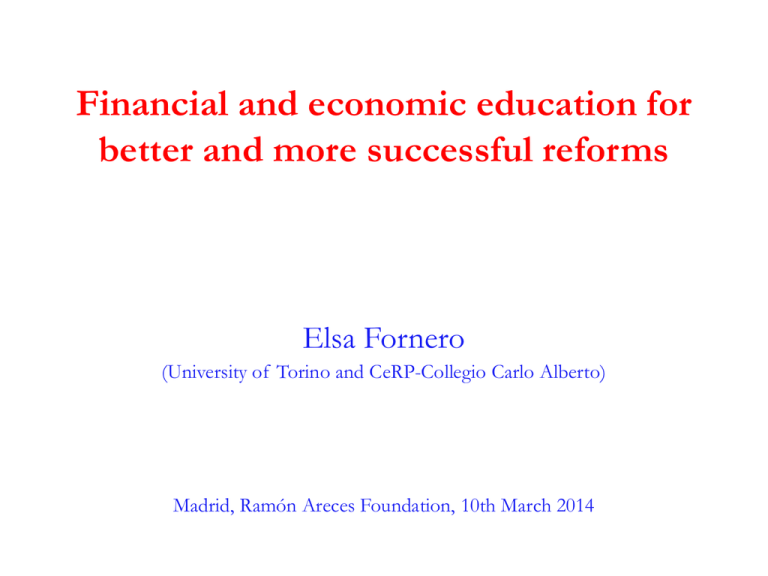The importance of financial and economic literacy
advertisement

Financial and economic education for better and more successful reforms Elsa Fornero (University of Torino and CeRP-Collegio Carlo Alberto) Madrid, Ramón Areces Foundation, 10th March 2014 The never ending plea for (economic) reforms • As a result of the financial/economic crisis and the harsher global competition, many countries have (had) to undergo structural and far-reaching reforms • Main areas: welfare system, labor market, public employment, liberalization of protected sectors and of the so-called “liberal” professions • With economic reforms, citizens face, in general, immediate costs versus uncertain future benefits their understanding thus becomes a (necessary, but not sufficient) condition for the reform to succeed March 2014 Elsa Fornero, University of Torino and CeRP 2 Definition of “reform” i. «To improve (an existing institution, law, practice, etc.) by alteration or correction of abuses» ii. «To give up or cause to give up a reprehensible habit or immoral way of life» (Wordreference.com) March 2014 Elsa Fornero, University of Torino and CeRP 3 The respective role of political parties and of expert/technocrats in realizing reforms • Economic reforms are usually a mix of political and technical elements, the former in the forefront of communication, the latter more behind the scene • When “selling” the reform to the public, political parties typically tend to look at reforms from an ideological perspective and to conceal their more “technical” aspects • This schemes weakens or break up in emergency situations, where the technical aspects of reforms become dominant; it is then the task of technocrats (or of experts from international institutions granting aids) to prepare the reforms • Technocrats however do not rely on ideological message to communicate the reform and if the public does not understand its basic principles, it risks being repealed or having little effects Financial literacy thus matters not only for individual wellbeing, but also for society March 2014 Elsa Fornero, University of Torino and CeRP 4 Financial and economic literacy in individual and collective choices Lack of financial literacy has typically been associated to the risk of poor saving choices during the life cycle. This risk is indeed increasing, together with individual responsibility, as a result of both the retrenchment of the welfare state and the greater sophistication of today’s financial markets Financial-economic literacy may be crucial for the success of economic reforms (particularly emergency-driven reforms). Lack of understanding may cause the reform to be reversed/greatly revised or its incentives not to work A conclusion strongly derived from my own experience as an economist (unexpectedly) turned the Italian Minister of Labor, Social Policies and Equal Opportunities March 2014 Elsa Fornero, University of Torino and CeRP 5 Understanding pension reforms/1 why are reforms needed • Financial unsustainability: ever growing “implicit” debt • Economic unsustainability (poor scheme design): inefficient allocation of risks: inability to cope with the effects of demographic and economic changes inefficient incentive structure : incentives to early retirement bad redistribution (segmentation of schemes, privileges) lack of transparency “excessive” political interference • Social unsustainability (inadequacy of old age provisions): inadequate insurance coverage type of pension benefits (indexation of benefits to wages?) inadequate provisions for Long Term Care inadequacies in the amount and composition of wealth in old age March 2014 Elsa Fornero, University of Torino and CeRP 6 Understanding the PAYG system/2 A matter of financial-economic literacy • PAYGs return depends on demographic and economic trends. The generosity of today’s system cannot be independent of the (structurally worsened) situation, with a rapidly aging population and a decline in economic growth • Understanding two elements of unsustainability of a public pension scheme: i) the political tendency to favor the present generations at the expense to the young and future ones ii) the inability of badly designed systems to effectively respond to the economic and demographic challenges means understanding its implicit debt dimension March 2014 Elsa Fornero, University of Torino and CeRP 7 Understanding the PAYG system/2 • “Acquired rights” or unsustainable privileges? A call for equity and intergenerational re-balancing behind the reform • When people understand that their pension “entitlements” were built on debt to be honored by future generations they can be less hostile to pensions restructuring • An expensive pension system is financed mainly from contribution on workers; trade-off between generous pensions and high cost on labor. March 2014 Elsa Fornero, University of Torino and CeRP 8 Understanding Defined Contribution • The knowledge of compound interest is crucial to understand that pension wealth is accumulated by paying contributions and that each euro paid into their “retirement account”, particularly at younger ages, will be capitalized. • The concept of risk diversification, properly understood even if only at its core, could help people in their decision to participate in a pension fund, as a way to combine both an unfunded and a funded pension, as they are characterized by different risk/returns combinations. (Retrenchment in the public system may lead to more diversified pension wealth) • Postponing retirement contributes twice to the benefit increase. March 2014 Elsa Fornero, University of Torino and CeRP 9 Italy - November 2011: the looming financial crisis and the sense of urgency March 2014 Elsa Fornero, University of Torino and CeRP 10 The 2011 “cold shower” reform • Application, as of Jan 2012 and for future seniorities, of the DC formula to all workers, with periodic (every 2 years) updates of annuity rate coefficients • Increases in the statutory retirement ages (66+longevity, in 2018) and phasedown of seniority pensions • Alignment, as of 2018, of ages and seniority requirements for women in the private sector to those of men/women in the public sector • Indexation of eligibility requirements to life expectancy (three preceding years var) • Increases in payroll tax rates for farmers and the self-employed • Temporary freeze of indexation for average-high pensions (>1400 €) • Solidarity tax on higher pensions (sadly cancelled, later, by the Constitutional Court) • Free “totalization” of contributions for NDC benefits • Elimination of “exit windows”, by which workers had to wait 12/18 months to retire after reaching pensionable age March 2014 Elsa Fornero, University of Torino and CeRP 11 Transitional and communication problems • Due to the emergency situation (prospect of a financial crisis), the social dialogue had to be foregone • Insufficiency of data caused insufficiency of safeguarding clauses and the need for subsequent amendments • The reform aims at dismantling the rooted notions that: workers over 54-55 are lost to the labor market and just destined to retirement elderly workers take away jobs from younger ones • Difficulties in: having the reform understood overcoming the notion of “acquired rights” explaining the implied generational rebalancing March 2014 Elsa Fornero, University of Torino and CeRP 12 Labor and pensions: two sides of the same coin As Franco Modigliani’s life cycle hypothesis has taught us long ago, work and retirement are two matching segments of our life. No pension system can deliver adequate benefits if the labor market – which generates the resources on which current pensions are paid does not perform adequately March 2014 Elsa Fornero, University of Torino and CeRP 13 The “lump of labor fallacy” The “lump of labor fallacy” – the idea that jobs are in a fixed number so that early retirement by the elderly makes room for jobs for the young – has long dominated, in some countries, the public debate in the field of pension reforms and brought about policies directed at reducing the retirement age. This belief creates hostility towards the reform and obscures its generational rebalancing by making people believe that if retirement age is postponed there will be fewer opportunities for the young (and/or for women: as the same erroneous reasoning has also long been applied to women and reduced female labor market participation). March 2014 Elsa Fornero, University of Torino and CeRP 14 What is a labor market reform? • Changing market regulation: - how: incentives and disincentives vs legal requirements and prohibitions - how much? • Initial circumstances matter: structurally weak economy experiencing a deep depression • Social/political constraints should be taken into account • Trying to find a balance: a) between short-run and medium-run effects b) between conflicting goals of social partners and political parties March 2014 Elsa Fornero, University of Torino and CeRP 15 Understanding labor market reforms • High expectation for the reform to immediately create new jobs: is this justified? • Short term vs medium term: swift deregulation of the labor market vs building better work relationships (apprenticeship) • How to increase workers employability • How to design an effective (and not discouraging job search) social safety net • How to enhance productivity? March 2014 Elsa Fornero, University of Torino and CeRP 16 Spring 2012: tackling Italy’s long standing labor problems • Market dualism: protected (mainly men, over forty, in industries and government jobs) vs marginalized groups (the young, women and older workers), causing rigidities on one side and precariousness, on the other • Low participation rates, particularly among women and older workers • Unwarranted separation (also ideologically motivated) between school and work; insufficient vocational training and lack of adult education • Predominance of passive policies and poor or absent ALMP, regionally provided, with few exceptions • Very high fiscal wedge March 2014 Elsa Fornero, University of Torino and CeRP 17 A complex reform resting on five pillars 1. Flexibility in labor market entry 2. Flexibility in labor market exit 3. Social protection schemes 4. Employment services and activation policies 5. Follow up, monitoring and evaluation The reform has been the result of extensive consultation with the social partners and wide ranging debate leading to broad agreement in Parliament. It was then, however, rapidly disowned irrespective of a positive international evaluation as an important step in the right direction March 2014 Elsa Fornero, University of Torino and CeRP 18 Opposition and latent contradictions The trade unions opposed the reform for doing away with “guarantees”; employers for trying to limit abuses of flexible contracts that had fuelled an abnormal proliferation of short term, vulnerable and badly paid jobs A satisfactory equilibrium was finally reached that, if properly applied, will rebalance opportunities in favor of the young and improve the quality of labor, solving medium term problems Sadly, the reform was introduced right in the middle of a deep recession The absence of immediate results has been at the root of widespread criticism (and also of vicious personal attacks) However, the ultimate success of the reform rests upon the possibility of change in individual and collective behavior Reforms are living processes, not legal exercises. They need to be endorsed by the social partners as well as by institutions, the media and the public at large March 2014 Elsa Fornero, University of Torino and CeRP 19 Political double standards Political parties were well aware both that the pension and labor market reforms were long due and indispensable, and that they would entail a period sacrifices Parliament voted both reforms, but the same political forces that approved them, instead of helping to explain their content to people, immediately started to disown them and to criticize the technocratic government for its “austerity“ measures This is an example of lack of political courage. No political force in Italy was brave enough to say clearly that with this type of reforms things get worse before they get better March 2014 Elsa Fornero, University of Torino and CeRP 20 Lessons for an economist accidentally turned minister Has the “medicine” been too harsh? Reforms were the result of an emergency situation coupled with structural weaknesses, not of extravagant ideas The stop to the “Infraction procedure for excessive deficit” by the EU Commission (May 29th, 2013) shows that sacrifices are starting to pay; this is a good message to deliver to people In a democracy, however, technocratic governments may enjoy a parliamentary majority but are politically friendless and ministers introducing complex reforms stand alone In certain circumstances, this may however be the only real way to make deep structural and unpopular changes in advanced countries March 2014 Elsa Fornero, University of Torino and CeRP 21 Lessons that citizens should learn Concepts of tradeoffs and their time dynamics, pervasive in our life, should be part of our literacy: there is a cost to be paid for any benefit and the two are not necessarily synchronized Choices today have an impact in the future. This is also reflected in public budgets, so some basic knowledge of public finance (concepts of deficit and debt) should also be part of our financial literacy to avoid populist policies and their bad consequences. March 2014 Elsa Fornero, University of Torino and CeRP 22 Financial and economic education for better and more successful reforms Without the support of the public opinion and without transparent information by the media, reforms can easily be reversed or deprived from their intended effects or simply ignored Financial and economic literacy can crucially strengthen that support It is a structural reform, so do not be discouraged by lack of immediate results Start with children and targeted groups more at risks (women) Examples: The tax on housing wealth (IMU), introduced with the “Save Italy” decree (Nov 2011) by the technocratic government, has been suppressed to comply with a (populist) electoral promise, and later reintroduced with a different name (TASI) in 2014 Pension reforms in the past have also suffered from step backs (for example, it happened in 2008 when the retirement age was lowered) The labor market has seen abuses of various kinds, while the conditionality attached to unemployment benefits has hardly been applied) March 2014 Elsa Fornero, University of Torino and CeRP 23









